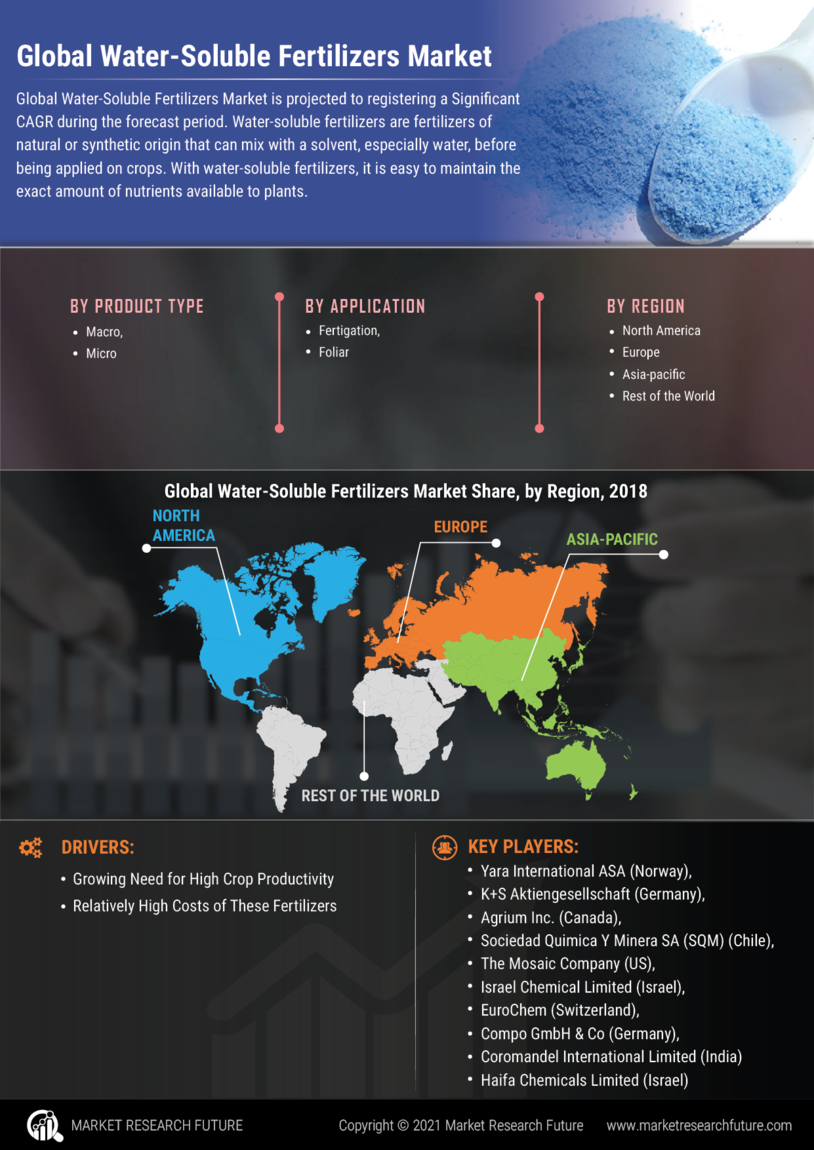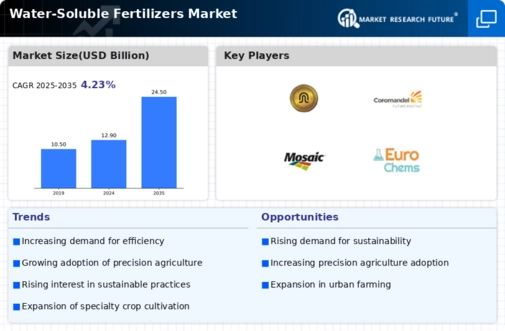Market Growth Projections
The Global Water-Soluble Fertilizers Market Industry is poised for substantial growth, with projections indicating a market size of 12.9 USD Billion in 2024 and an anticipated increase to 24.5 USD Billion by 2035. This growth trajectory suggests a compound annual growth rate of 5.95% from 2025 to 2035. Such projections reflect the increasing adoption of water-soluble fertilizers across various agricultural sectors, driven by factors such as technological advancements, sustainability trends, and the need for efficient nutrient management. The market's expansion is indicative of the evolving agricultural landscape and the critical role of water-soluble fertilizers in meeting future food production demands.
Increasing Demand for High-Quality Crops
The Global Water-Soluble Fertilizers Market Industry experiences heightened demand for high-quality crops, driven by consumer preferences for premium agricultural products. As farmers seek to enhance yield and quality, water-soluble fertilizers offer a precise nutrient delivery system that supports optimal plant growth. This trend is particularly evident in regions with intensive agricultural practices, where the need for efficient nutrient management is paramount. The market is projected to reach 12.9 USD Billion in 2024, reflecting the growing reliance on these fertilizers to meet the rising expectations of consumers and food manufacturers alike.
Expansion of Greenhouse and Hydroponic Farming
The expansion of greenhouse and hydroponic farming systems significantly influences the Global Water-Soluble Fertilizers Market Industry. These farming methods, which rely heavily on controlled environments, require precise nutrient management to optimize plant growth. Water-soluble fertilizers are particularly suited for these applications, as they provide immediate nutrient availability and can be easily adjusted to meet specific crop needs. The increasing popularity of urban farming and local food production initiatives further drives this trend. As more growers adopt these innovative farming techniques, the demand for water-soluble fertilizers is likely to surge, contributing to the overall market growth.
Global Population Growth and Food Security Concerns
Global population growth and the accompanying food security concerns are pivotal drivers of the Global Water-Soluble Fertilizers Market Industry. As the world population continues to rise, the demand for food production escalates, necessitating efficient agricultural practices. Water-soluble fertilizers play a crucial role in enhancing crop productivity and ensuring food security by providing essential nutrients in a readily available form. This urgency is reflected in the market's projected growth, with expectations of reaching 12.9 USD Billion by 2024. Addressing food security challenges through improved agricultural inputs is essential for sustaining the growing population.
Technological Advancements in Fertilizer Production
Technological advancements in fertilizer production processes contribute significantly to the Global Water-Soluble Fertilizers Market Industry. Innovations such as controlled-release formulations and enhanced solubility techniques allow for more efficient nutrient uptake by plants. These advancements not only improve crop yields but also reduce environmental impacts associated with traditional fertilizers. As a result, the market is likely to see an increase in adoption rates, particularly in developed regions where precision agriculture is gaining traction. The anticipated growth trajectory suggests that the market could reach 24.5 USD Billion by 2035, driven by these technological improvements.
Rising Awareness of Sustainable Agriculture Practices
The Global Water-Soluble Fertilizers Market Industry is witnessing a shift towards sustainable agriculture practices, as farmers become increasingly aware of the environmental impacts of conventional fertilizers. Water-soluble fertilizers, known for their efficiency and reduced runoff potential, align with sustainable farming goals. This trend is particularly pronounced in regions facing stringent environmental regulations. As sustainability becomes a focal point in agricultural policies, the demand for water-soluble fertilizers is expected to rise, potentially leading to a compound annual growth rate of 5.95% from 2025 to 2035. This shift underscores the importance of integrating eco-friendly practices into modern farming.















Leave a Comment